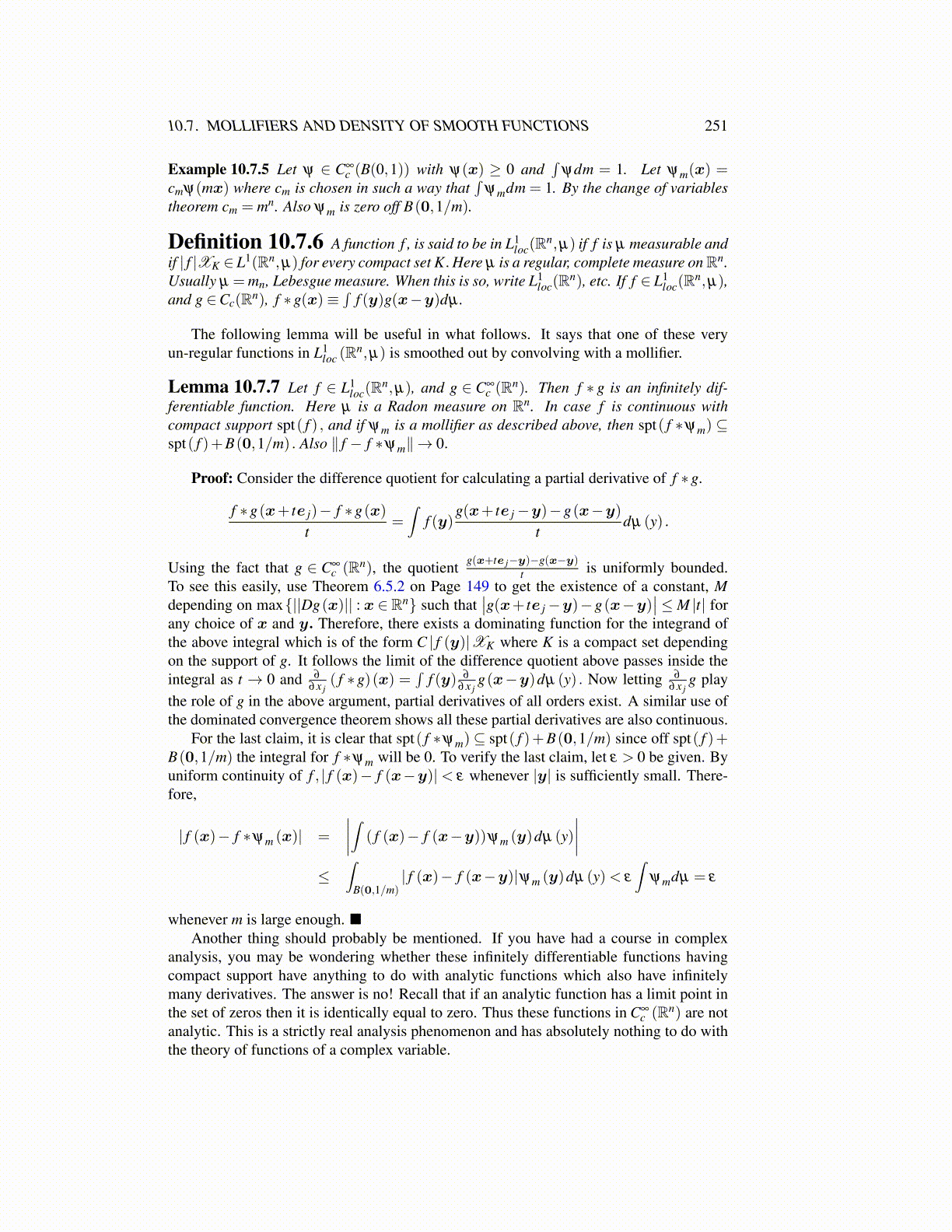
10.7. MOLLIFIERS AND DENSITY OF SMOOTH FUNCTIONS 251
Example 10.7.5 Let ψ ∈ C∞c (B(0,1)) with ψ(x) ≥ 0 and
∫ψdm = 1. Let ψm(x) =
cmψ(mx) where cm is chosen in such a way that∫
ψmdm = 1. By the change of variablestheorem cm = mn. Also ψm is zero off B(0,1/m).
Definition 10.7.6 A function f , is said to be in L1loc(Rn,µ) if f is µ measurable and
if | f |XK ∈ L1(Rn,µ) for every compact set K.Here µ is a regular, complete measure onRn.Usually µ =mn, Lebesgue measure. When this is so, write L1
loc(Rn), etc. If f ∈ L1loc(Rn,µ),
and g ∈Cc(Rn), f ∗g(x)≡∫
f (y)g(x−y)dµ .
The following lemma will be useful in what follows. It says that one of these veryun-regular functions in L1
loc (Rn,µ) is smoothed out by convolving with a mollifier.
Lemma 10.7.7 Let f ∈ L1loc(Rn,µ), and g ∈ C∞
c (Rn). Then f ∗ g is an infinitely dif-ferentiable function. Here µ is a Radon measure on Rn. In case f is continuous withcompact support spt( f ) , and if ψm is a mollifier as described above, then spt( f ∗ψm) ⊆spt( f )+B(0,1/m) . Also ∥ f − f ∗ψm∥→ 0.
Proof: Consider the difference quotient for calculating a partial derivative of f ∗g.
f ∗g(x+ te j)− f ∗g(x)t
=∫
f (y)g(x+ te j−y)−g(x−y)
tdµ (y) .
Using the fact that g ∈ C∞c (Rn), the quotient g(x+te j−y)−g(x−y)
t is uniformly bounded.To see this easily, use Theorem 6.5.2 on Page 149 to get the existence of a constant, Mdepending on max{||Dg(x)|| : x ∈ Rn} such that
∣∣g(x+ te j−y)−g(x−y)∣∣ ≤M |t| for
any choice of x and y. Therefore, there exists a dominating function for the integrand ofthe above integral which is of the form C | f (y)|XK where K is a compact set dependingon the support of g. It follows the limit of the difference quotient above passes inside theintegral as t → 0 and ∂
∂x j( f ∗g)(x) =
∫f (y) ∂
∂x jg(x−y)dµ (y) . Now letting ∂
∂x jg play
the role of g in the above argument, partial derivatives of all orders exist. A similar use ofthe dominated convergence theorem shows all these partial derivatives are also continuous.
For the last claim, it is clear that spt( f ∗ψm)⊆ spt( f )+B(0,1/m) since off spt( f )+B(0,1/m) the integral for f ∗ψm will be 0. To verify the last claim, let ε > 0 be given. Byuniform continuity of f , | f (x)− f (x−y)|< ε whenever |y| is sufficiently small. There-fore,
| f (x)− f ∗ψm (x)| =
∣∣∣∣∫ ( f (x)− f (x−y))ψm (y)dµ (y)∣∣∣∣
≤∫
B(0,1/m)| f (x)− f (x−y)|ψm (y)dµ (y)< ε
∫ψmdµ = ε
whenever m is large enough. ■Another thing should probably be mentioned. If you have had a course in complex
analysis, you may be wondering whether these infinitely differentiable functions havingcompact support have anything to do with analytic functions which also have infinitelymany derivatives. The answer is no! Recall that if an analytic function has a limit point inthe set of zeros then it is identically equal to zero. Thus these functions in C∞
c (Rn) are notanalytic. This is a strictly real analysis phenomenon and has absolutely nothing to do withthe theory of functions of a complex variable.